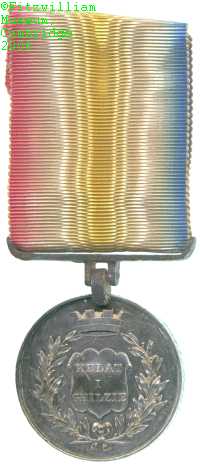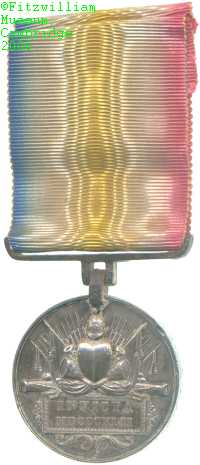Defence of Khelat-i-Gilzie Medal, awarded to Havildar Maun Singh 1842

Obverse, shield bearing inscription, surrounded by laurel wreath and surmounted by mural crown |

Reverse, inscription around the central cavity |

Obverse, shield bearing inscription, surrounded by laurel wreath and surmounted by mural crown |

Reverse, inscription around the central cavity |
The First Afghan War of 1839 had culminated in the British restoration of the Shah Shujah al-Mulk, a situation which caused his dissatisfied people to rise in revolt in 1841. The murder of the British envoy provoked an initial evacuation of the British garrison, most of which was massacred on its march back to India. The British forces in Afghanistan were for a short while confined to those at the fort of Khelat-i-Ghilzai and the garrison of Jalalabad.
Khelat-i-Ghilzai withstood an even longer siege than Jalalabad, holding out for four months before its eventual relief in the campaign that restored British control in the area. For participation in the defence of the town the British East India Company issued this silver medal to all combatants.
The particularly dogged defence by the Shah's own Afghan contingent in the town caused them to be enrolled in the British forces in Bengal thereafter as the Khelat-al-Gilzie Regiment, otherwise listed as the 2nd Battalion of the 2nd Bombay Pioneers. One of these men was Havildar Maun Singh, and this is his medal. Lester Watson purchased it at some point before 1928.